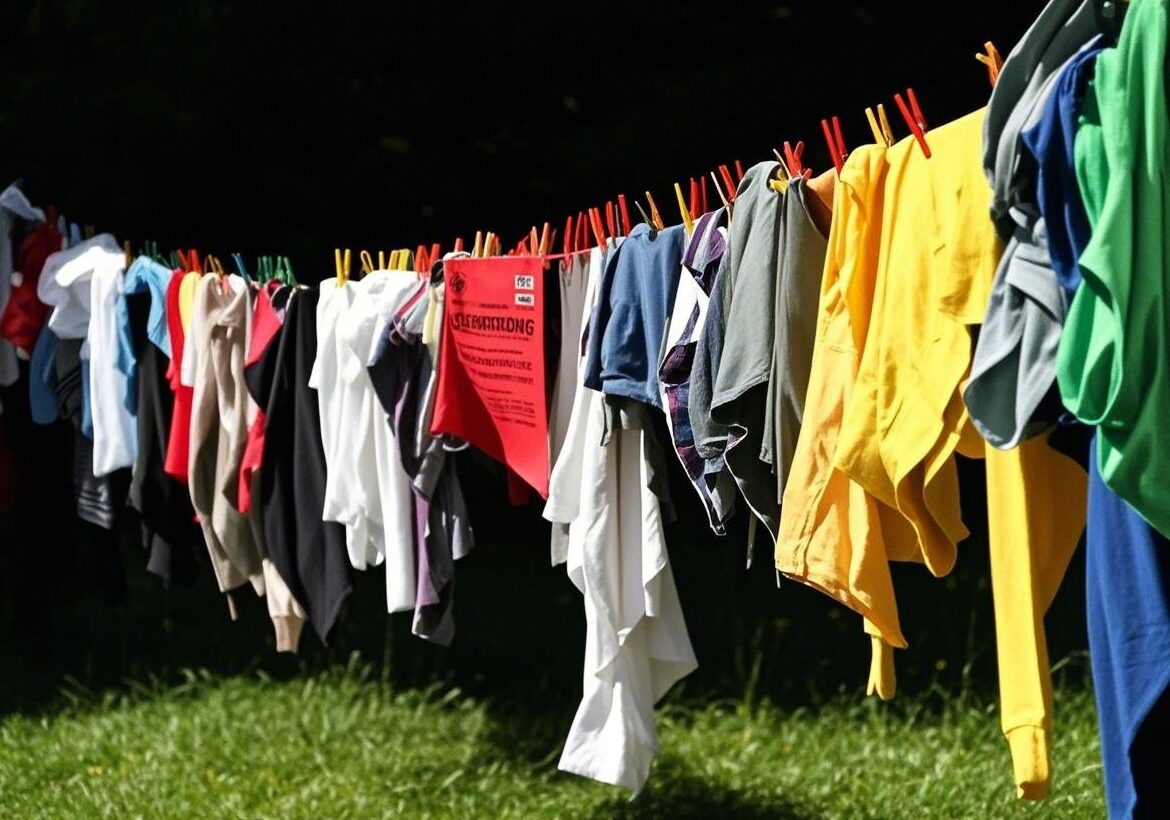When you think of drying clothes, you probably picture them swaying gently in the breeze under the warm sun. It’s a classic image, but have you ever wondered if hanging clothes outside is always the best option? Many of us have been raised to hang laundry outdoors, but this seemingly harmless practice comes with some surprising drawbacks. Let’s dive into why it’s often better to rethink this habit.
The Risks of Hanging Clothes Outside
Exposure to Harmful UV Rays
While sunlight may seem like a great natural dryer, the reality is that prolonged exposure to UV rays can weaken fabrics. Over time, UV light breaks down fibers, causing them to become brittle and fade. The result? Clothes lose their vibrant colors and softness. It’s not just your favorite t-shirt that’s at risk—delicate fabrics like cotton and linen can also suffer the effects of UV exposure.
Increased Dust and Pollution
If you live in a city or an area with heavy traffic, your clothes might not just be drying in the sun—they’re collecting dust, dirt, and pollutants from the environment. Fine particles from car exhaust, industrial pollution, and even allergens can latch onto your freshly washed clothes, making them not as clean as you thought. This can be particularly concerning for individuals with respiratory issues or allergies.
Potential for Mold and Mildew
Humidity is another significant concern when hanging clothes outside. In areas where the air is moist, the drying process can take longer, increasing the likelihood of mold or mildew. These fungal spores thrive in damp conditions, and if your clothes aren’t drying fast enough, they could develop an unpleasant smell and even become a health hazard.
The Impact of Pollen and Allergens
In addition to dust and pollution, outdoor environments can expose clothes to pollen, pet dander, and other allergens. This can be a major issue for individuals who suffer from seasonal allergies or asthma. These allergens can settle on your clothes and be transferred to your skin or respiratory system, worsening allergy symptoms.
Environmental Factors to Consider
The Weather’s Role in Drying Clothes
Weather conditions play a massive role in how efficiently clothes dry outside. On a sunny day, clothes might dry quickly, but what happens when the weather doesn’t cooperate? If it’s overcast, rainy, or humid, your clothes might stay damp for hours or even days. This can be especially problematic if you have a busy schedule and need your laundry done in a timely manner.
Why Humidity Can Be a Problem
In high-humidity areas, the air is saturated with moisture, making it difficult for clothes to dry. Instead of soaking up moisture, your clothes may remain wet for much longer, which can increase the risk of mildew growth. Even when the sun is out, humidity can hinder the drying process, leaving you with clothes that smell less than fresh.
How Wind and Rain Affect Clothes
Wind may seem like a helpful ally in speeding up the drying process, but it also comes with its downsides. Strong winds can cause clothes to flap around, which might result in stretching or even tears, especially for lighter fabrics. And, of course, unexpected rain can ruin your efforts in an instant. Even if you think the weather is fine, conditions can change quickly, leaving you with soggy clothes that need to be rewashed.
The Impact on Fabric and Clothing Durability
UV Damage and Fabric Fading
As mentioned earlier, UV rays can cause irreversible damage to fabrics. Not only do they fade colors, but they also weaken the fibers, making them more prone to wear and tear. If you have clothes made from delicate materials like silk or wool, this is a real concern. By hanging them outside too often, you could drastically shorten their lifespan.
Friction from Wind and Outdoor Elements
When clothes flap in the wind or rub against surfaces, it can lead to physical damage. The constant friction can wear down the fibers, resulting in thin spots, fraying, and tears. It’s not just the wind that poses a threat—rough surfaces like fences or laundry lines can also cause abrasions.
How Weather Conditions Affect Different Fabrics
Different fabrics react differently to outdoor elements. Delicate fabrics like silk or wool can lose their sheen or become misshapen when exposed to wind or moisture. On the other hand, heavier fabrics like denim might withstand outdoor conditions better but can still become stiff or faded over time. Understanding how different fabrics react to the elements is crucial in protecting your clothing.
Health and Hygiene Considerations
The Presence of Bacteria and Germs
Outdoor drying can expose clothes to bacteria and germs present in the air. This is particularly concerning in areas near sewage systems, dumpsters, or industrial zones. Even when clothes are freshly washed, they can pick up harmful microorganisms from the environment, compromising their cleanliness.
Potential Skin Irritations from Contaminated Clothes
If you have sensitive skin, wearing clothes dried outside could lead to irritation. Pollutants, pollen, and other environmental contaminants can linger on your clothes and cause allergic reactions, rashes, or other skin issues. For those with skin conditions like eczema or psoriasis, this can be particularly troublesome.
The Risk of Breathing in Outdoor Pollutants
Even if your clothes don’t make direct contact with pollutants, drying them outside in a polluted area can expose you to harmful particles. As your clothes dry, tiny particles of dust, pollen, and other allergens can be released into the air, where you might breathe them in. This can exacerbate asthma or other respiratory conditions.
Alternatives to Hanging Clothes Outside
Indoor Drying Options
One of the best alternatives to hanging clothes outside is using an indoor drying rack. These racks allow your clothes to dry indoors without exposing them to harmful outdoor elements. They’re perfect for rainy days or when you want to avoid the risk of outdoor pollutants.
Using Drying Racks and Heated Drying Spaces
For faster drying, consider using a heated drying rack or setting up a drying space with good airflow. These methods can help your clothes dry more quickly, even indoors, without the need for outdoor exposure.
Energy-efficient Dryer Machines
If you prefer not to hang clothes inside, energy-efficient dryer machines are a great option. These dryers use less energy than traditional models, helping you reduce your carbon footprint while drying clothes indoors quickly and safely.
When Hanging Clothes Outside Might Be Beneficial
Low-Pollution Areas and Clean Air
If you live in a rural area with clean air and low pollution, hanging clothes outside may not be as risky. In such environments, the benefits of sun-dried clothes—such as fresh air and natural softness—might outweigh the potential downsides.
Clothes That Benefit from the Sun
Certain items, like white linens or towels, can benefit from the sun’s natural bleaching effect. In these cases, a little exposure to the sun can help keep your fabrics looking bright and fresh without significant damage.
The Eco-friendly Aspect of Outdoor Drying
Hanging clothes outside is an eco-friendly practice because it reduces energy consumption. If done in the right conditions, outdoor drying can be a sustainable way to get your laundry done without relying on electricity.
Conclusion
While hanging clothes outside may seem like a natural and eco-friendly way to dry laundry, it comes with a range of potential risks. From UV damage to exposure to pollutants, allergens, and even mold, there are several reasons to reconsider this practice. Fortunately, there are plenty of indoor drying alternatives that protect your clothes, your health, and the environment.
FAQs
Is it safe to hang clothes outside on a sunny day?
While sunlight can help dry clothes quickly, the UV rays can cause fading and damage to fabrics over time. It’s best to limit exposure for delicate items.
Can hanging clothes outside damage expensive fabrics?
Yes, expensive fabrics like silk, wool, and cashmere are more susceptible to damage from UV rays, wind, and outdoor conditions.
How can I dry clothes effectively without risking damage?
Using an indoor drying rack, a heated drying space, or an energy-efficient dryer machine are great alternatives to outdoor drying.
Are there any benefits to hanging clothes outside?
Outdoor drying can be beneficial in areas with low pollution, as it allows clothes to dry naturally and can reduce energy consumption.
What is the best alternative to drying clothes outdoors?
Indoor drying racks, heated drying spaces, and energy-efficient dryers are excellent alternatives that provide a safer and more controlled environment for drying clothes.

